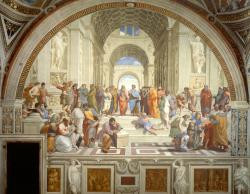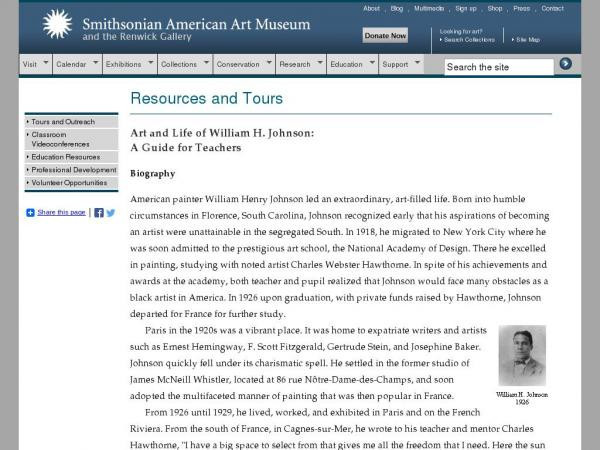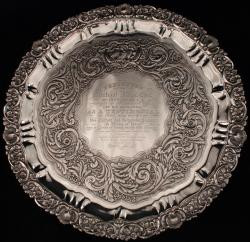Kate Harris
Social Studies teacher
Pittsburgh CAPA
Middle School (13 to 15 years old), High School (16 to 18 years old)
Teacher/Educator
Language Arts And English, Civics, Literature, Cultures, Economics, Social Studies, Geography, Writing, US History, Arts, Other
I'm a history-lover, art fan, and bookworm. I taught high school history (U.S. History and World Religions) for ten years in North Carolina, teach currently in Pittsburgh, PA, and am working to help teachers make the most of this new resource!
Kate Harris's collections
Identifying Characteristics of Renaissance Art
This collection will teach you about how Renaissance artists changed the style and focus of art in the period between 1300 and 1600 CE. When you are done, you should be able to thoroughly answer the question: How did the art of the Renaissance reflect the new emphasis on humanism and science?
First, review the painting, Raphael's School of Athens, and learn about the new techniques used.
Then study the additional works in the collection and try to use them as examples of the different techniques. Some of the works are from the Renaissance period and others are more modern interpretations. A worksheet is included at the end of this collection to record your work.
Finally, test your knowledge with a quick quiz. Use your worksheet to help!
 Kate Harris
Kate Harris
11
Samurai Armor
This collection invites students to consider samurai armor as both functional and expressive objects. The collection includes two informative videos, several examples of samurai armor, photographs, and quiz questions. It finishes with an optional extension activity to make and decorate an origami samurai helmet. This collection can be used independently by students.
Guiding questions to consider are:
1) Why does the material, design, and purpose of an item of clothing matter?
2) How did samurai use their armor to affirm their social status?
3) How did samurai armor evolve over time and reflect changes in Japanese culture?
 Kate Harris
Kate Harris
19
New Deal Organizations: Relief, Recovery, or Reform?
For each of the images in the collection, determine which New Deal organization it is representing. Think about whether that organization is a good example of relief, recovery, or reform. Some images can be used in more than one way, so be prepared to defend and explain your answers to the class.
 Kate Harris
Kate Harris
28
The End of World War I
This collection asks users to consider how unresolved issues from WWI may have led to the outbreak of war again in the 1930s. Included is a letter from a soldier on the end of the war, a summary of the Treaty of Versailles, a painting and a political cartoon.
The collection asks students to evaluate the predictions about future wars made by the letter's author and then to evaluate how and why the Treaty of Versailles may have failed.
Tags: World War I, Treaty of Versailles, League of Nations, armistice, interwar, World War I, Hitler
 Kate Harris
Kate Harris
5
School Integration
<p>The topic of K-12 school integration is a complex one that goes far beyond an understanding of that landmark case, Brown v. Board of Education of Topeka, Kansas. How have efforts at integration been sustained in the 60+ years since that case was first decided? How have concerns about socioeconomic differences been addressed (or not addressed) through school districting? How do district and national policies impact individual students for better or worse? This is a topical collection that addresses the history of school integration but also includes references to and resources reflecting the issue today.</p><p>Tags: segregation, Little Rock Nine, desegregation, charter schools, Arkansas, busing, Boston, racism, prejudice, civil rights</p>
 Kate Harris
Kate Harris
14
Discover the Story: A Miner's Life
This collection includes objects and artifacts representing life in as a miner. Students are challenged to write a creative story or narrative based on the objects in the collection, illustrating life at the time. The last two resources in the collection are a worksheet that teachers may use to frame the assignment and a grading rubric for the assignment.
Tags: Pennsylvania, narrative, Pittsburgh, mining, miner, immigration, coal, worker safety, child labor
 Kate Harris
Kate Harris
16
Frederick Douglass and "What to the Slave Is the Fourth of July?"
<p>In this collection, students will review the life of Frederick Douglass and learn about one of his most famous speeches, "The Meaning of Fourth of July for the Negro" (it is also commonly referred to as "What to the Slave is the Fourth of July). They will explore the strategies he uses to persuade and compare staged readings of the speech. Next, they will consider the central question posed by Douglass--how does the history of racial injustice in the United States affect our understanding of national symbols and what they mean? In addition, how do the diverse opinions of the many citizens of the United States present both challenges and opportunities for our nation? </p><p>Teachers may draw relevant connections to today and recent protests during the national anthem by professional, collegiate, and high school sports teams. </p>
 Kate Harris
Kate Harris
13
Watch Night
<p>This collection asks students to examine an image entitled "Waiting for the Hour" and to try to determine its meaning and purpose. Students will practice interpretation with justification and then learn more about the history of "watch night services" and the importance of the 1862 watch night in United States history. They will also consider the legacy of this image--a copy is currently hanging in the White House. </p><p>tags: emancipation, freedom, Civil War, Abraham Lincoln, proclamation</p>
 Kate Harris
Kate Harris
4
Evolution of an Artist: William H. Johnson
<p>The clippings, paintings, and other items here will all help you develop an understanding of William H. Johnson's life and growth as an artist. First, read the biography in the first resource. Then, try to order the remaining collection items from earliest to latest, using clues from the informational text and the style and subject of each work. Once finished, review the progression you have created. How would you describe the evolution of Johnson's art? Can you connect changes in his art to world or personal events?</p><p>tags: Harlem, Federal Art Project, sorting, folk art, African-American, painter</p>
 Kate Harris
Kate Harris
31
All You Need is Love
<p>The best of love-themed graphic design in the Smithsonian Institution's collections. </p>
 Kate Harris
Kate Harris
12
Responses to Immigration: Then and Now
<p>This collection will prompt thinking about attitudes towards new immigrants throughout our nation's history. What has changed and what has stayed the same?</p><p>It is also designed to allow users to explore the range of technical features and content resources available in the Smithsonian Learning Lab.</p><p>tags: immigrant, America, assimilate, nativism, stereotypes</p>
 Kate Harris
Kate Harris
10
The Irish Experience in Pittsburgh
<p>Created for the AIU3 workshop on 3/17/17, this topical collection includes images from Historic Pittsburgh (<a href="http://digital.library.pitt.edu/images/pittsburgh/">http://digital.library.pitt.edu/images/pittsburgh/</a>), the Smithsonian Collection, the records of the Ancient Order of Hibernians in the Detre Library and Archives, Heinz History Center, and additional web resources. This large group of documents is intended to be shaped and whittled into useful collections for individual classrooms. Teachers might consider linking the documents to themes like:</p><p>•Immigration</p><p style="margin-left:32px;">•Push and Pull factors</p><p style="margin-left:32px;">•Growth of social networks</p><p style="margin-left:32px;">•Assimilation</p><p style="margin-left:32px;">•Nativism</p><p style="margin-left:32px;">•Contributions (Political, Cultural, Military, Philanthropy)</p><p>•Industry in Western PA</p><p>•Labor Movement</p><p><br /></p><p>To make this collection your own, copy it and then use the edit feature to add and remove documents as well as contribute any annotations that might help your students. </p>
 Kate Harris
Kate Harris
29











